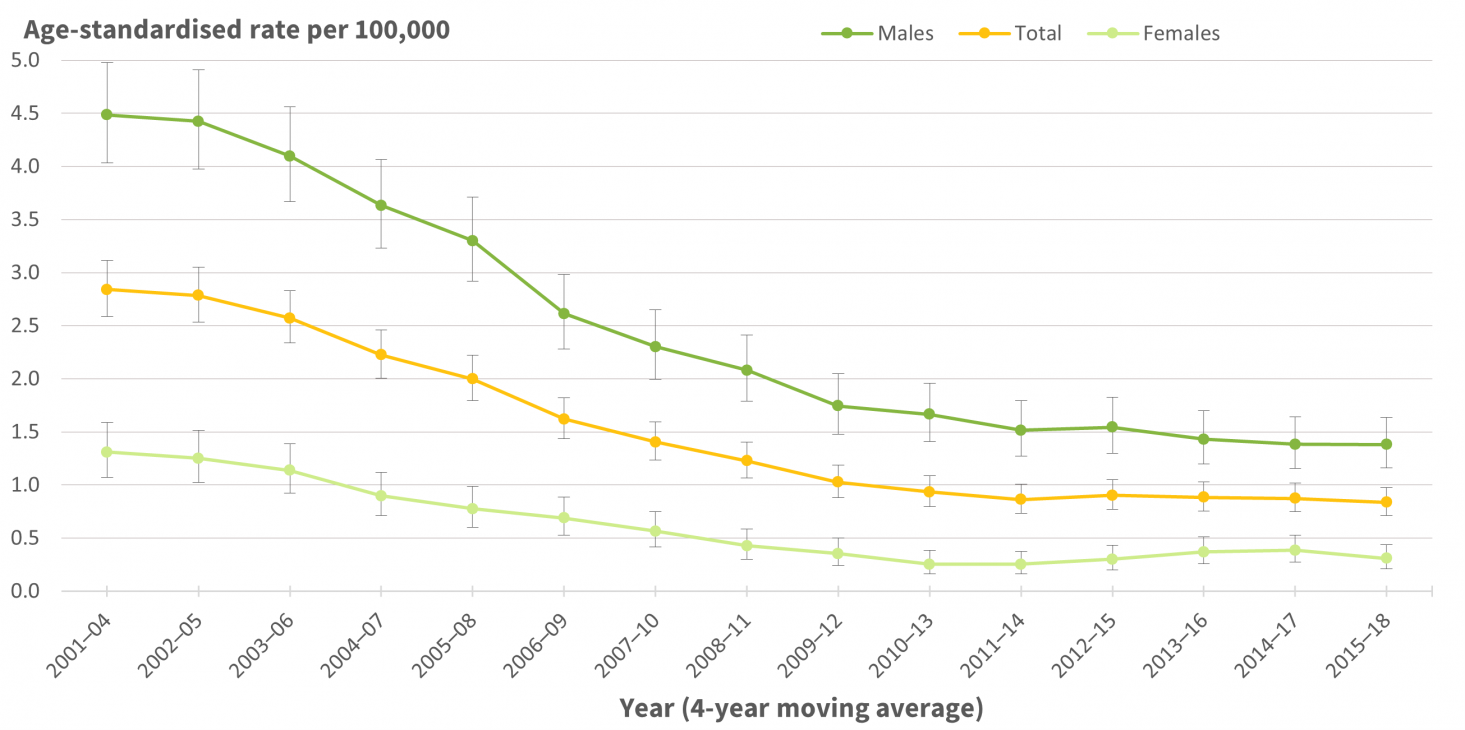Hazardous substances-related deaths registered in New Zealand
This section presents information on all deaths related to hazardous substances in Aotearoa New Zealand from 2001–18. The data comes from the New Zealand Mortality Collection dataset from the Ministry of Health.
On this page:
Deaths from hazardous substances are often preventable
Every year, people in New Zealand continue to die from exposure to hazardous substances. Common exposures include inhalation of carbon monoxide, huffing of butane, and exposure to pesticides, solvents, cleaning agents, and paints. These deaths are often preventable [1].
Hazardous substances-related deaths decreased since 2001–04
In 2018, there were 40 hazardous substances-related deaths within New Zealand. The number of deaths has been similar since 2011. From 2001–04 to 2015–18, mortality rates have decreased by approximately 70% (2.8 per 100,000 compared to 0.8 per 100,000) (Figure 1).
Figure 1: Hazardous substances-related mortality rate, by sex, 2001–18

Notes: 95% confidence intervals have been presented as error bars. See Metadata for more information on how to interpret this graph.
Source: New Zealand Mortality Collection, Ministry of Health (2021).
Differences in the characteristics of people whose deaths were related to hazardous substances
Among people whose deaths were related to hazardous substances from 2001–18 there were:
Differences by ethnic group:
From 2001–04 to 2015–18, mortality rates for European/Other and Māori ethnic groups decreased by over 60%. Over the same time, rates among Pacific Peoples have not changed substantially.
From 2001–18, over a third of all hazardous substances-related deaths recorded for Māori and Pacific Peoples were listed as unintentional deaths. This is substantially higher than the proportion of unintentional deaths recorded for European/Other and Asian ethnic groups, 7% and 4% respectively.
Differences by age:
Among children (0–14 years), there were a total of four deaths related to hazardous substances from 2015–18. Given these low counts, rates were not calculated. Mortality rates in all age groups 15 years and older were similar over this time period.
Differences by region:
In 2015–18, West Coast District Health Board experienced a higher hazardous substances-related mortality rate than the New Zealand rate.
For a further breakdown of demographic information, as well as graphs and tables, see the Surveillance report.
A breakdown of hazardous substances-related deaths, 2001–18
There were 1,284 hazardous substances-related deaths recorded in New Zealand from 2001–18, with the most common category being carbon monoxide poisonings, accounting for 78% of deaths. Of all the hazardous substance categories, gases, fumes and vapours deaths are the only category that increased substantially from the 2000’s to the 2010’s. See Table 1 below for a full breakdown.
Information about the data
This indicator reports on hazardous substances-related deaths registered in New Zealand using data from 2001 onwards. This indicator is an analysis of the most recent data available from The Mortality Collection Dataset, provided to EHINZ by the Ministry of Health in August 2021. Data has been pooled to give sufficient numbers for analysis where appropriate.
This surveillance report includes data covered by the Hazardous Substances and New Organisms Act 1996 and Health Act’s
“poisoning arising from chemical contamination of the environment”. For more information, see metadata for ICD-10 codes that are covered in this analysis.
Crude rates presented in this report do not take into account varying age distributions when comparing between populations.
Age-standardised rates presented in this report take into account varying age distributions when comparing between populations
